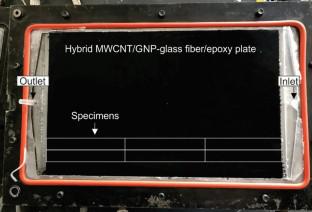Evaluation of the Piezoresistive Response of GFRP with a Combination of MWCNT and GNP Exposed to Seawater Aging
Abstract
The purpose of this work was the evaluation of electrical conductivity and piezoresistive response of seawater aged glass fiber/epoxy composites (GF/E) with the incorporation of multiwall carbon nanotubes (MWCNTs), graphene nanoplatelets (GNPs) and their hybrid combination (MWCNT/GNP) at two mixing ratios (7:1 and 3:1). Seawater exposure leads to the phenomenon of moisture absorption in GF/E, which negatively affected their bending properties, causing a higher susceptibility to damage mechanisms related to matrix cracking, fiber/matrix interfacial debonding and delamination. However, the addition of MWCNT/GNP hybrids to the GF/E composites induced a positive effect on the electrical response resulting in improved piezoresistive properties (strain sensitivity) and damage sensing under monotonic flexural loading. The results of piezoresistive response experiments also confirmed excellent strain sensing capabilities under cyclic loading condition for both unaged and aged composites, demonstrating the efficiency of using the hybrid combination of MWCNTs and GNPs for electrical sensing applications of composite structures in seawater aged conditions. It was found that the 3:1 mixing ratio allowed better electrical performance of GF/E composites and piezoresistive capability was preserved even after sea water aging.


 求助内容:
求助内容: 应助结果提醒方式:
应助结果提醒方式:


